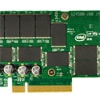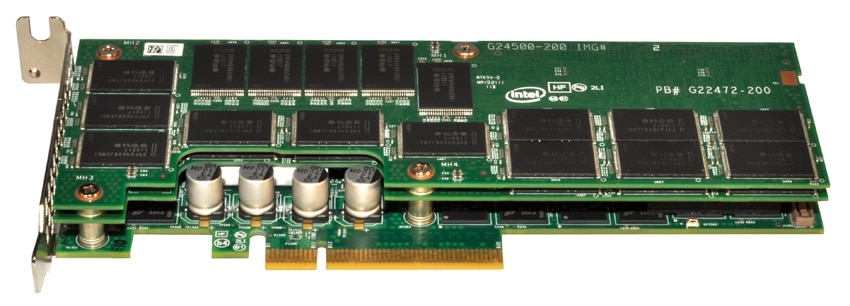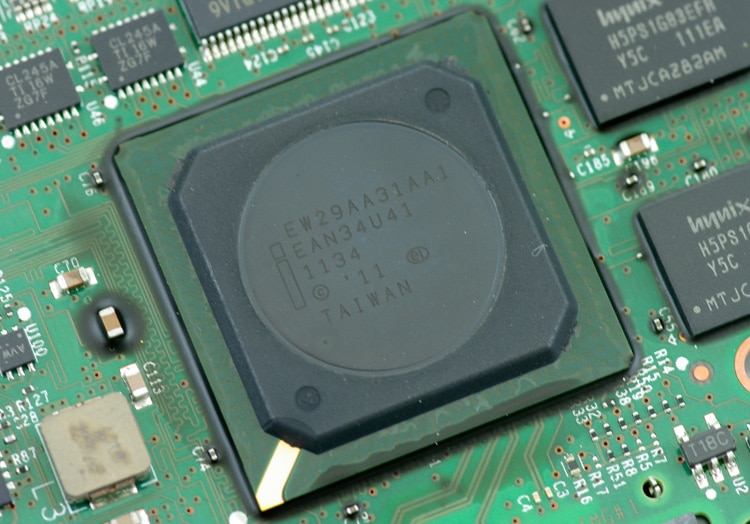
Update: Intel SSD 910 Series Enterprise PCIe Review
If Intel had its way, every hard drive would be replaced by an Intel powered SSD. Currently Intel offers products spanning small mSATA SSDs all the way up to eMLC-based high-endurance enterprise SSDs. Missing from this broad portfolio is a high-performance PCIe solution, to compete with others in the enterprise space including the LSI Nytro family, Fusion-io ioDrive2, OCZ Z-Drive R4, and others. In comes the Intel SSD 910 Series; designed for I/O intensive datacenter operations with very aggressive pricing; $1,929 for the 400GB capacity and $3,859 for 800GB. At these prices, datacenters that have even considered enterprise-class SATA/SAS SSDs too expensive for widespread deployment may take a serious look.
Intel SSD 910 Specifications
- Capacities:
- 400GB
- Sequential 128K Performance – 1,000MB/s Read, 750MB/s Write
- Random 4K Performance – 90,000 IOPS Read, 38,000 IOPS Write
- Endurance – 5PB to 7PB Written (4K or 8K block writes)
- 800GB
- Sequential 128K Performance – 2,000MB/s Read, 1,000MB/s Write
- Random 4K Performance – 180,000 IOPS Read, 75,000 IOPS Write
- Endurance – 10PB to 14PB Written (4K or 8K block writes)
- 400GB
- Intel EW29AA31AA1 Controller (two inside 400GB model, four inside 800GB model)
- Intel 25nm Enterprise MLC NAND
- Read / Write Latency: 65 / 65 μs
- Interface: PCI Express 2.0 X8 Half-Height, Half-Length add-in card
- Dimensions H x L x W: 69 x 168 x 19mm
- Weight: 125 / 190g (400 / 800GB)
- Power Consumption: Active: <25W Typical Idle: 8 / 12W Typical (400 / 800GB)
- Operating Temperature: 0°C to 55°C with 200 LFM (linear feet per minute) airflow
- RoHS Compliance: Meets the requirements of European Union (EU) RoHS Compliance Directives
- Product Health Monitoring: Intel SSD Data Center Tool, Self-Monitoring, Analysis and Reporting Technology (SMART) attributes, SCSI log pages
- Compatibility:
- Windows Server 2008 R2 SP1/SP2
- Windows Server 2003 R2 SP2
- Windows 7
- Red Hat Enterprise Linux 5.5, 5.6, 6.1
- SUSE Linux Enterprise Server 11
Designed to Replace I/O-intensive HDDs
The Intel SSD 910 Series is a PCIe-based SSD that offers a post-deployment storage upgrade that requires no changes to existing server design. The SSD 910 is intended for storage tiering and caching of hot files for high-performance processing and access to mission-critical data where one Intel 910 SSD might replace multiple 15K rpm hard disk drives (HDDs) to save on space and power consumption and also improve sequential performance, storage scalability, and reduce latencies.
Intel rates the SSD 910 800GB PCIe SSD at up to 2GB/s of sustained sequential reads and 1GB/s sequential writes. For I/O intensive workloads such as 4K random access, its rated up to 180,000 IOPS read and 75,000 IOPS write. The 800GB Intel SSD 910 provides 60% greater sequential read performance with 60X greater random read and 20X greater random write performance than eight short-stroke RAIDed 10k RPM SAS HDDs connected to a PCIe Host Bus Adapter (HBA). These gains translate into higher CPU utilization as storage access bottlenecks are eliminated. Intel expects that the 910 series will make a strong case to adopt SSD for high-performance applications like data center virtualization, on-line transactions, and cloud computing.
Endurance and Reliability
The SSD 910 uses an integrated Intel controller and management firmware designed for less NAND wear, NAND error reduction and system error via Intel High Endurance Technology (HET). The SSD 910 comes with optimized multi-level cell (MLC) 25-nanometer NAND flash memory that allows up to 10 full drives writes a day for five years, or a 30x endurance improvement over Intel’s standard MLC-based flash products, based on 8K random writes and comparing Intel HET SSD solutions to SSD solutions based on standard Intel MLC NAND flash memory.
Performance with Compatibility
Powering the Intel SSD 910 are a set of two or four Intel EW29AA31AA1 controllers. This controller is also found in the Hitachi Ultrastar SSD400M and SSD400S.B enterprise SSDs, which Intel partnered with Hitachi to build. Shown below is the EW29AA31AA1 controller found inside the SSD400M.
We measured performance from the single-controller SAS-interfaced Ultarstar SSD400M in excess of 57,000 IOPS 4K random read, with extremely strong 4K steady-state performance. Scaling that up with additional controllers is a recipe for a high-performance PCIe SSD solution, coupled with reliability found in the popular LSI SAS2008 PCI-Express to SAS bridge. This is the same chipset powering the LSI 9211 HBA which we use exclusively in our enterprise testing platform and is also found inside other enterprise PCIe solutions such as the LSI WarpDrive SLP-300.
Intel is also going for wide-spread compatibility with the SSD 910 by using the popular LSI SAS2008 chipset; having native support in most operating systems already. Out of the gate Intel offers support for Windows and many Linux variations. They are also opting not use an Option Rom, which bypasses BIOS conflicts that can sometimes occur on uncertified platforms. Similar to Fusion-io with the ioDrive and ioDrive2 Duo, Intel isn’t linking the internal flash LUNs through on-board hardware RAID. Instead they push software RAID through the host system, which further increases compatibility and performance across multiple platforms. The downside to this implementation is the SSD 910 is non-bootable, but given the low-cost nature of SATA SSDs as boot drives, they feel that buyers wouldn’t want to dedicate space on a fast PCIe SSD for the OS.
Pricing and Availability
Samples are now available from Intel for data center customers to begin quality and validation cycles. General production availability is scheduled for mid-2012. Suggested pricing is $1,929 for the 400GB capacity and $3,859 for 800GB SSD 910.



